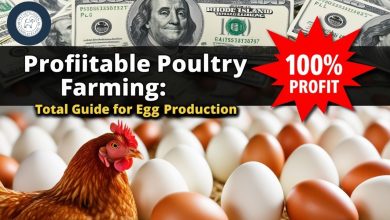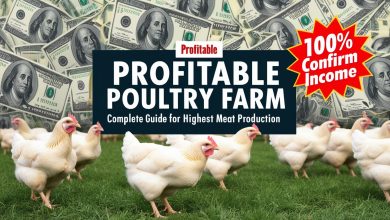Profitable Household Pigeon Farming: for Meat Production

Household pigeon farming involves raising pigeons in a small-scale setup, typically within a household area such as a backyard or rooftop. This type of farming is particularly suitable for urban and semi-urban areas, providing families with a sustainable source of meat and additional income. Pigeons are hardy birds that require minimal space and resources, making them an excellent choice for small-scale farming.
Table of Contents
Types of Pigeons for Pigeon Farming
Pigeons raised for meat are commonly referred to as “squabs.” The most suitable pigeon breeds for meat production are:
1. King Pigeon: Known for their large size and rapid growth, making them ideal for meat production.
2. Homer Pigeon: Also used for meat, though they are slightly smaller than King pigeons.
3. Runt Pigeon: One of the largest pigeon breeds, providing substantial meat yield.
4. Mondain Pigeon: Known for their plump bodies and high meat quality.
Initial Setup: Cost and Area Requirements for Pigeon Farming
Total Cost: Setting up a household pigeon farm involves several expenses:
– Housing: Pigeons require lofts or coops for shelter. A small loft with multiple compartments can be built for around BDT 10,000 to BDT 15,000.
– Breeding Pairs: Pigeon breeding pairs cost between BDT 500 to BDT 1,000 each. Starting with 10 pairs will cost between BDT 5,000 to BDT 10,000.
– Equipment: Basic feeders, drinkers, and nesting materials can cost around BDT 2,000 to BDT 5,000.
– Feed: Pigeons primarily eat grains such as corn, wheat, and millet. Monthly feed cost for 20 pairs is approximately BDT 2,000 to BDT 3,000.
– Vaccines and Medication: Regular vaccination and health check-ups are necessary. This can cost around BDT 1,000 to BDT 2,000 initially.
Total Initial Investment: BDT 20,000 to BDT 35,000.
100k Profit Duck Farming : Visit Now
Area Requirements for Pigeon Farming
A small area in the backyard or rooftop of about 100-200 square feet is sufficient for housing 20 pairs of pigeons. Ensure the loft is well-ventilated, predator-proof, and easy to clean.
Best Pigeon Breeds for Meat Production and Their Prices
– King Pigeon: BDT 500 to BDT 1,000 per pair.
– Homer Pigeon: BDT 400 to BDT 800 per pair.
– Runt Pigeon: BDT 700 to BDT 1,200 per pair.
– Mondain Pigeon: BDT 600 to BDT 1,000 per pair.
Food Requirements: Quality, Quantity, and Cost for Pigeon Farming
Quality: Provide a balanced diet consisting of grains, legumes, and occasionally greens. Supplements such as grit and minerals are also essential.
Quantity: Each pigeon consumes about 30-50 grams of feed per day.
Cost: Monthly feed cost for 20 pairs is around BDT 2,000 to BDT 3,000.
Vaccination Schedule and Costs
– Paramyxovirus: Administer at 4 weeks old and annually thereafter (BDT 5 per bird).
– Pigeon Pox: Administer at 8 weeks old (BDT 5 per bird).
– Salmonella: Administer as needed, based on veterinary advice (BDT 5 per bird).
Total Vaccination Cost: Approximately BDT 15 per bird.
Common Diseases and Medicines
Common Diseases:
– Canker: Treat with metronidazole.
– Coccidiosis: Treat with amprolium or sulfa drugs.
– Paratyphoid: Treat with antibiotics like enrofloxacin.
Medicine Cost:
– Young Pigeons (0-4 weeks): BDT 10 per bird.
– Adult Pigeons: BDT 15 per bird.
Total Medicine Cost: BDT 25 per bird.
Potential Earnings
If everything is managed properly, each pigeon pair can produce 10-12 squabs annually. Squabs can be sold at around BDT 300 to BDT 500 each.
For 20 pairs, potential earnings from squabs alone can be around BDT 60,000 to BDT 120,000 annually. After deducting costs, the profit can be substantial.
1million Profit Buffalo Farm : Visit Now
Advice for Bangladeshi Farmers for Pigeon Farming
1. Start Small: Begin with a manageable number of pigeon pairs to understand the market and farming practices.
2. Quality Feed: Invest in high-quality feed to ensure the health and productivity of the pigeons.
3. Regular Vaccination: Follow the vaccination schedule strictly to prevent diseases.
4. Proper Housing: Ensure proper ventilation and space to prevent overcrowding and diseases.
5. Market Research: Understand the market demand and price fluctuations to maximize profits.
6. Record Keeping: Maintain detailed records of expenses, health, and production for better management.
Conclusion
Starting a pigeon poultry farm for meat production in a household setting in Bangladesh can be a profitable venture with the right planning and management. By following the guidelines mentioned above, farmers can ensure high returns and contribute to the local poultry industry. For more detailed information, you can visit [Pet Vet Guides] & FAO.




